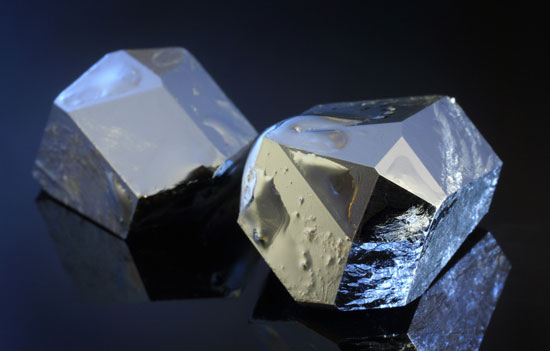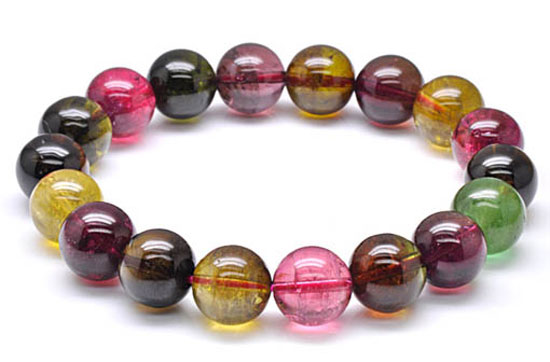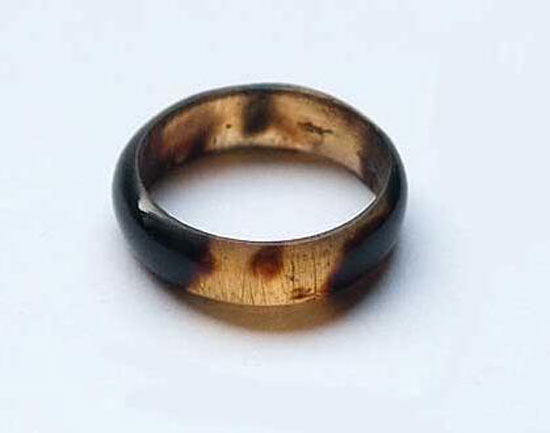1. Diamond:

A diamond is a crystalline mineral that is completely crystallized from a single element of carbon. It is also one of the few gemstones in a gemstone. Diamonds are octahedral cleavage, that is, the four directions of the plane octahedral crystal plane, generally stepped. Diamonds are chemically stable and are not easily soluble in acids and bases. However, in pure oxygen, decomposition occurs when heated to about 1770 degrees. In a vacuum, when heated to 1700 degrees, it is broken down into graphite. Diamonds are transparent, translucent, and opaque. Gem-quality diamonds should be colorless and transparent, flawless or rarely flawed, or slightly yellowish or very light brown. The more precious colors are natural pink, followed by blue and green.
2. Pearl:
When pearly seawater or freshwater shellfish mollusks enter small impurities, the mantle is stimulated to secrete a kind of pearl (mainly calcium carbonate), which is wrapped in a layer of fine impurities and gradually becomes a small round bead. It is a pearl. The color of the pearl is mainly white, pink and light yellow, with pearl luster, and its surface is faintly shimmering with rainbow-like faint pearls. The color is white, the skin is bright, the shape is round, and the particle size is hard.
3. Turquoise:
Turquoise is a self-colored gemstone that is a fully hydrated copper aluminophosphate. The molecular formula is cual6(po4)4(oh)5h2o. The transparency of the turquoise is opaque and the lower part of the sheet is translucent. The polished surface is greased glass and the fracture is dull and glossy. The types of turquoise include Persian Stone, American Turquoise and Mexican Turquoise, Egyptian Turquoise and turquoise with iron wire.
4. Lapis Lazuli:
Lapis lazuli is a mineral of the sodalite family; the molecular formula of lapis lazuli is (na,ca)7-8(al,si)12(o,s)24(so4),cl2cl2·(oh)2(oh) 2, wherein sodium is often partially replaced by potassium, and sulfur is partially replaced by sulfate, chlorine or selenium. The types of lapis lazuli include Persian lapis lazuli, Soviet lapis lazuli or Spanish lapis lazuli, and Chilean lapis lazuli.
5. Opal Stone:
Opal stone minerals are of the type of opal, the molecular formula is sio2·nh2o. Because the small beads of sio2 in the opal are arranged neatly like a grating, when the white light is incident on it and then diffracted and scattered into a color spectrum, the opal stone has a brilliant color, especially the red is more precious. Opal stone types include white opal stone, black opal stone, crystalline opal stone, fire opal stone, colloidal opal stone or jade drop opal stone, boulder opal stone, gangue opal stone Or opal stone in the matrix.
6. Peridot:
Peridot is a self-colored gemstone. Common colors are pure green, yellowish green to brownish green. Olivine is not colorless. The molecular formula is: (mg, fe) 2sio4. The types of olivine include peridot, topaz, forsterite, fayalite, "dusk emerald" and borologite.
7. Feldspar:
Feldspar is classified into two main types by mineralogy: feldspar and plagioclase. The molecular formulas are: kalsi3o8, naalsi3o8. The types of feldspar include moonstone or feldspar, feldspar of daylight stone or lapis lazuli, labradorite, tianhe stone or amazon stone.
8. Jade:
Jade points jade (also known as jade), nephrite. Jadeite is a sodium and aluminum silicate with the formula: naal(sio3)2. Nephrite is an aqueous calcium magnesium silicate with the molecular formula: camg5(oh)2(si4o11)2.
9. Quartz:
Quartz is a gemstone of its color, pure quartz is colorless and transparent. The molecular formula is sio2. Quartz types include crystal, halo or red quartz, rutile spots or mesh rutile quartz, amethyst, citrine, smoky quartz or smoky quartz, hibiscus, dongling, blue quartz, milk quartz, blue quartz or Sapphire quartz, tiger eye, eagle or falcon eye, quartz cat's eye, starred or star quartz.
10. Chalcedony:
Chalcedony is also called cryptocrystalline quartz. The molecular formula is sio2. The types of chalcedony include moonstone, green chalcedony, red agate, red carnation, bloodstone, green chalcedony, agate, onyx, jasper, dark green chalcedony, chalcedony, and silicified wood.
11. Garnet:
Garnet is named after the crystal and pomegranate seeds are very similar in shape and color. The general formula of garnet is r3m2(sio4)3. The types of garnet include iron aluminum garnet, magnesium aluminum garnet, magnesium iron garnet, manganese aluminum garnet, calcium iron garnet, calcium chrome garnet.
12. Zircon:
The zircon color is red, yellow, blue, purple, and the like. The molecular formula is zrsio4.
13. Spinel:
The spinel is yellow, green and colorless. The molecular formula is mgal2o4. Types of spinel include red spinel, ruby-colored spinel or ruby ​​spinel, purple or garnet-like spinel, powder or rose spinel, orange-red spinel, Blue spinel, sapphire spinel or sapphire spinel, rhomboid-like spinel, black spinel, iron-magnesium spinel or magnesium iron spinel.
14. Topaz:
Topaz is a fluorosilicate of aluminum, orthorhombic. The molecular formula is al2(f, oh)2sio4. The types of topaz include brownish yellow to yellowish brown, light blue to light blue, pink, colorless, and other varieties.
15. Tourmaline:

A more complex boroaluminosilicate of the tourmaline, which may contain one or more of the following components: magnesium, sodium, lithium, iron, potassium or other metals. These elements have different proportions and different colors. The types of tourmalines include red, green, blue, yellow and orange, colorless or white, black, variegated gemstones, cat's eye tourmaline, and chameleon-like tourmalines.
16. Golden Green Jade:
Rhododendron is a spinel group mineral, aluminate. The main component is alumina crucible, which is an orthorhombic system. The molecular formula is beal2o4. The types of golden sapphire include stone, opal, stone cat jewel and other variants.
17. Beryl:
Beryl is colorless in its pure state; different variants have different colors due to the presence of trace metal oxides. In the presence of chromium oxide or vanadium oxide, it usually becomes emerald, while aquamarine is colored by ferrous oxide. The sapphire is due to the presence of magnesium, while the beryl is colored by iron oxide. The molecular formula is: be3al2(sio3)6. The types of beryl include emerald, aquamarine, maxixe beryl, beryl, beryl, other transparent varieties, cat's eye beryl, and star beryl.
18. Corundum:
Corundum is a very common mineral. Except for star gemstones, only translucent to transparent variants can be called gemstones. The molecular formula is al2o3, containing chrome oxide in red, containing titanium and iron oxide in blue, containing iron oxide in yellow, containing chromium and iron oxide in orange, containing iron and titanium oxide in green, containing chromium, titanium and iron oxide in purple. . Corundum types include rubies, star rubies, sapphires, brilliant sapphires, and star sapphires.
19. Amber:
Amber is an organic substance. It is a petrochemical turpentine containing some ancient trees related to turpentine. The molecular formula is c40h64o4. The types of amber include Haiper, Hangpo, Jiepo, Block, Lipper, Turber, Bubble, and Bone.
20. Coral:
Corals are another gem material for biogenesis. It is the dendritic calcium skeleton of coral polyps formed with the proliferation of small marine animals.
21. Coal jade:
Coal jade is a variant of lignite (the main component is carbon and contains hydrogen and oxygen). It is made by the compaction of driftwood. The driftwood settles to the bottom of the sea and becomes a buried fine-grained silt, which is then transformed into hard shale, called “coal jade rockâ€. Coal jade is a biological cause. Coal jade is amorphous, with a dull luster on a rough surface and a glass luster on a polished surface.
22. Tortoiseshell:

Tortoiseshell is amorphous, with a lustrous to waxy luster and a hardness of 2.5.
23. Synthetic corundum:
Synthetic corundum refers to man-made materials that have substantially the same physical, optical, and chemical properties as compared to natural corundum.
24. Synthetic Gems:
Synthetic gemstones are synthetic gemstones that have essentially the same physical, optical, and chemical properties as compared to natural gemstones. Synthetic gemstones include synthetic rutile, barium titanate, yttrium aluminum garnet, gallium garnet, synthetic cubic zircon, synthetic sapphire, synthetic spinel, synthetic rutile, synthetic marble, synthetic diamond, synthetic emerald, synthetic Europe Moored, synthetic quartz.
25. Double Stone:
The doublet stone is also called composite stone, which is a gemstone made of two different materials. The type of doublet stone is classified according to the nature of the material used in the bonding. The types of double stones are garnet and glass double stone, emerald substitute, opal stone substitute, star sapphire substitute, diamond substitute, and other various imitation gemstones.
Carpet Protector,Carpet Protector Mat,Desk Chair Mat For Carpet,Floor Protector Mat
Taizhou Ruihu Plastics Co.,Ltd , https://www.tzruihu.com